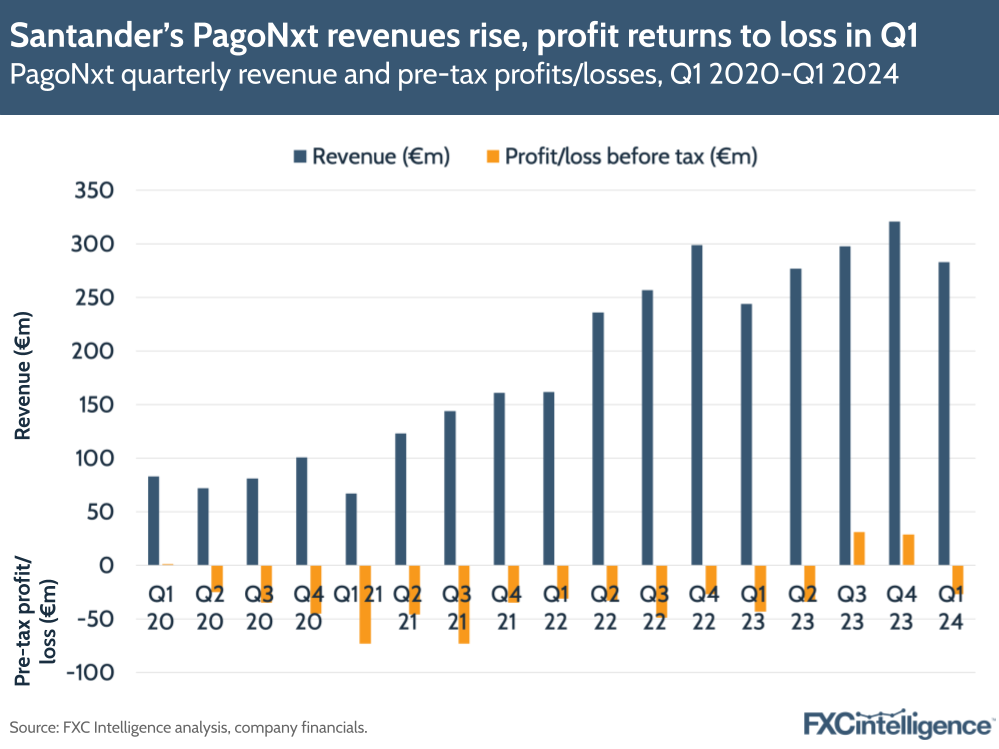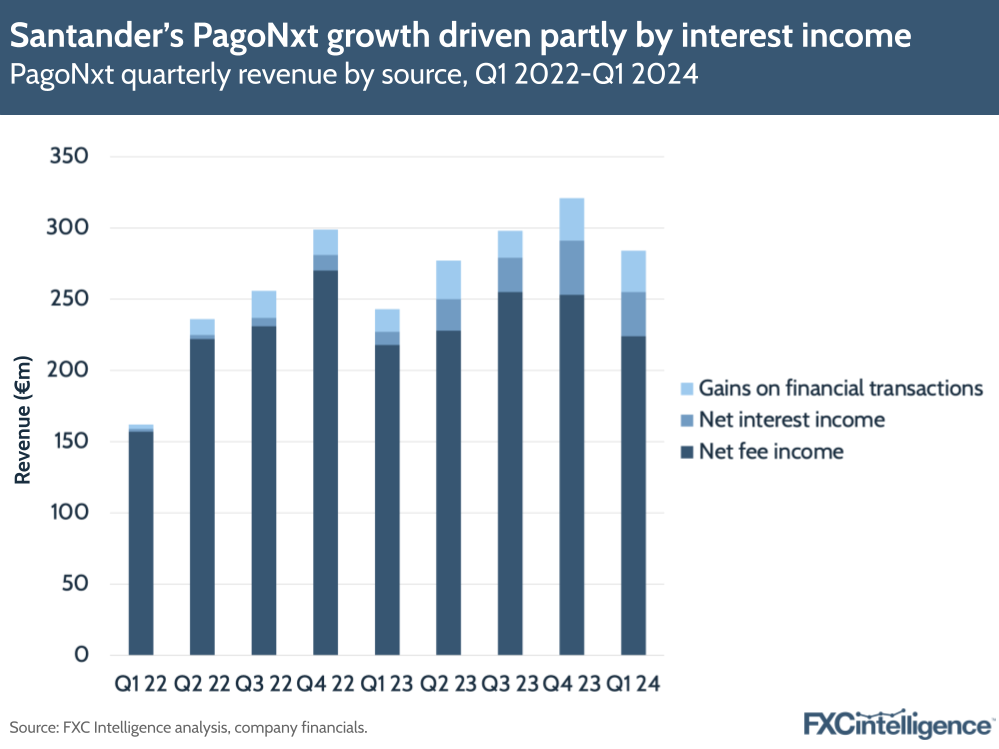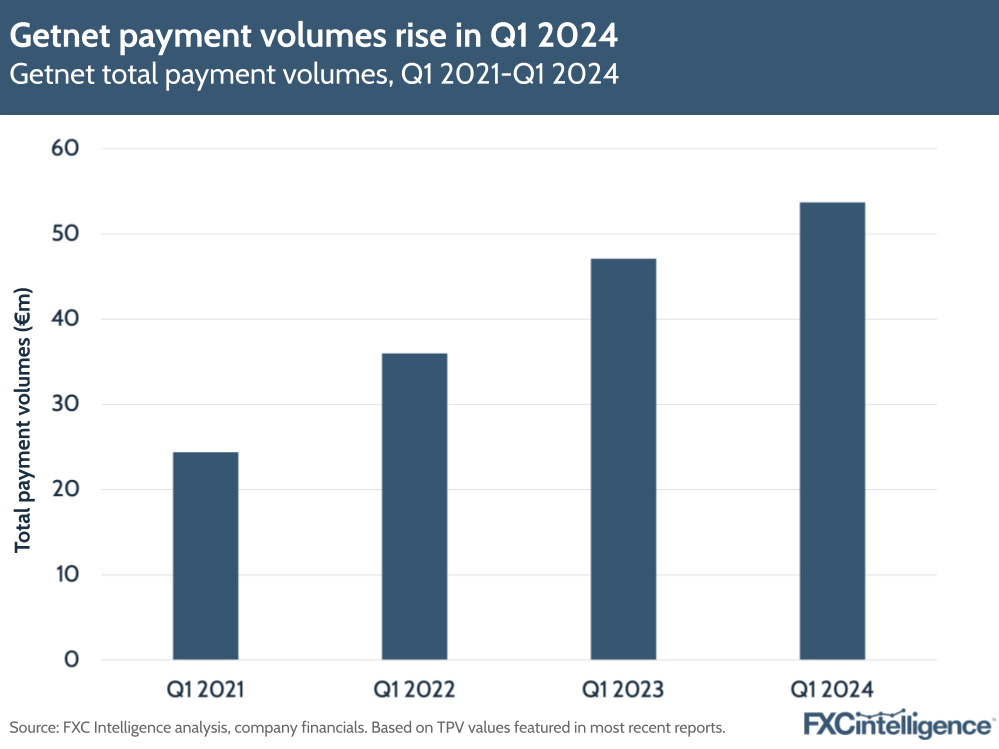Santander’s PagoNxt saw revenues rise 16% (13% in constant euros) to €283m in Q1, and has also reported its quarterly EBITDA margin for the first time, which stands at 17% (up from 7.5% in Q1 2023). Rising merchant volumes and interest rates helped propel the business, which now forms part of Santander’s recently created Payments segment.

The gain in EBITDA margin is a positive step towards PagoNxt’s target of 30% by 2025; however, it did not publish the underlying figures for the margin.
In terms of profit figures before tax, the company returned to a loss in Q1 2024 at -€27m, though this is lower than the -€43m in Q1 2023. In terms of overall P&L attributable to the parent company, PagoNxt delivered losses of -€39m in Q1 2024, though again this was lower than -€55m in Q1 2023.
Santander repositioning its payments segment
Since December 2023, Santander has updated its reporting structure to combine its Cards business – previously part of the bank’s Retail Banking segment – with PagoNxt into a new segment called Payments. PagoNxt itself continues to cover A2A payment processing, as well as merchant acquiring through Getnet and business payments through Ebury.
Overall, this combined Payments segment saw an attributable profit of €137m, a rise of 29% per year (23% in constant euros) in Q1 2024. The move to bring the two segments together means that Payments now accounts for €1.4bn, around 9% of Santander’s overall Q1 revenue of €15.4bn.

Out of the Payments segment specifically, PagoNxt only accounts for 21% of this revenue yet PagoNxt revenues rose 16% YoY while Cards revenue declined by -0.2%. It should be noted however that although in constant currency terms this would have been 13% and -3% respectively, Santander reported that Cards growth would have been 5% excluding a one-time positive fee related to commercial agreements in Brazil in Q1 2023.
Overall, the Payments segment delivered €265m in profit before tax, which consists of €292m of profit from Santander’s Cards segment, offset by losses of -€27m from PagoNxt. Though the restructuring has bolstered the significance of Payments as a product for Santander, it has also revealed that, despite solid growth, PagoNxt is still only a smaller contributor to the bank’s overall revenues.
Getnet growth offsets rising costs
PagoNxt’s revenue growth was backed by a 13% decline in cost per transaction, driven by the company’s efforts in capex optimisation.
However, Santander did note that, across its Payments division, costs have risen by 8% due to inflationary pressures and platform investments. In addition, it said that it had continued to build out alternative payment options for customers through new wallet agreements during the quarter.

Total payments volume for Getnet rose 14% in constant euros, while the number of transactions improved by 13% to 2.4 billion.
During Q1, Getnet continued to develop its global platform and prepare expansions for new markets such as the UK. On the earnings call, Santander CEO Héctor Grisi said that Getnet was growing its market share, with active merchant growth particularly strong in countries where Getnet has been mostly rolled out such as Chile, Spain or Portugal. Meanwhile, Ebury launched new operations in Brazil and has seen a 20% rise in active customers to 22,000.
One notable driver of revenue growth over time has been net interest income, which rose by 231% to €31m, while gains on financial transactions also grew by 80% to €29m. By comparison, net fee income rose by 3% to €224m. The rise in interest income reflects wider gains that have been seen from higher interest rates across Santander during this period.
Launching a new Global Cards platform
Santander also mentioned the development of a new global cards platform, Plard, through which it is already managing around 45,000 debit cards and plans to migrate more through projects in Brazil and Chile.
Plard has been one of the platforms that have driven costs upwards in the Payments segment, offsetting income growth in the Cards division, though this saw other solid growth figures, including a 6% rise in turnover to €78bn, while the total number of cards offered by the company grew to 102 million.
In the earnings call, Grisi said that cost efficiency and optimising capital expenditure will continue to drive profitability for PagoNxt in the coming quarters. He also said that around one billion annualised transactions are running through the global platform currently, and that the company expects this volume to double by the end of the year.
Santander’s reframing of PagoNxt alongside its Cards division may have softened its impact on the wider banking group, but PagoNxt is continuing to report growth while reducing pre-tax losses YoY.


